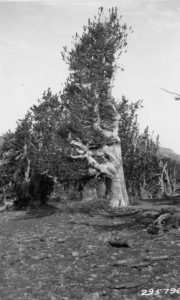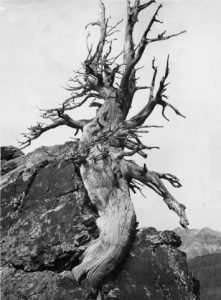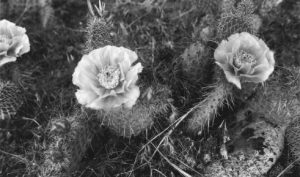
Cottonwood tree, South Temple 600 West, SLC, UT
Betty Wullstein, Utah History Encyclopedia, 1994
The diverse landscapes of Utah result in a wide variety of environmental conditions in which plants may become established. This entry briefly describes the habitats and major plant communities that may be encountered in traveling from the upper mountain peaks to the lower desert valleys. In addition, brief descriptions are provided of selected, common plant species in each habitat.
ABOVE TIMBERLINE
The climate of the mountain peaks of the Uinta Mountains and the Wasatch Mountains is characterized by relative dryness, abundant sunlight, and rapidly changing temperature. A few plants are found above timberline on the very highest peaks, such as Kings Peak (13,538 feet), Mount Timpanogos (11,750 feet), and Mount Nebo (11,871 feet). Timberline begins at about 11,500 feet above sea level. In general, the soils are shallow and the growing season short. In order to survive, plants growing above timberline must grow vigorously and produce viable seeds in a short time. Many of the plants above timberline have beautifully colored, dwarf, highly fragrant flowers, and the time of flowering varies among the different species. Above-timberline plants include forget-me-nots–the only known blue flower encountered above timberline; cushions of pinkish-purple moss campions; alpine avens–largest white-flower, mat-forming plant found here; bistorts–a slender swaying plant with upright spikes of white flowers that look like tufts of cotton from a distance; pale yellow or rose-purple Indian paintbrush; harebells–single dark blue, funnel-shaped flowers; mat-forming mountain dryads with eight-petaled, creamy-white flowers and scalloped leathery leaves on a woody stem; alpine willow–dwarfed, rarely growing over 2 dms (8 inches) high.
UPPER MONTANE VEGETATION
This community occurs commonly between about 8,000 and 9,000 feet. The following trees may be encountered: Englemann spruce–square needles in cross-section and small cones; white fir–flat, blunt needles about 5-7 cm long, and yellow-greenish or greenish-purple cones standing upright on limbs; Limber pine–five needles in a bundle and cones up to six inches long; Bristlecone pine–resin spotted, five needles in a bundle; Douglas fir–soft, flat needles with petiole (stalk-like) base, hanging cones with snake-like projections; Quaking aspen–straight, white-barked trunks; Lodgepole pine–slender tree with two needles in a bundle, found in Uinta Mountains; Subalpine fir–single, flat needles, branchlets without hairs, dark purple cones that stand upright on tree and glisten with resin.

Pine tree, foxtail pine in Dixie National Forest
Many colorful flowers can also be encountered in this region: larkspur–deep blue flowers and deeply cut leaves; mountain bells–bell-shaped pink or blue flowers, leaves opposite; senecio–4-6 inches high, thickish succulent leaves, yellow sunflower-like flowers in headed clusters; monkshood–helmet-shaped purple-blue flowers in loose upright cluster, alternate toothed leaves which are deeply incised about base, largest leaves at base, poisonous; daisies–lavender rays and large yellow discs; white marsh marigold–buttercup-like flower, shiny dark green basal leaves; monkey flowers–irregular snapdragon-like flower, leaves opposite, found in wet areas; white bog orchids–green, rose, greenish-white or blue-purple, all orchids have three sepals and three petals; gentians–oblong opposite leaves, funnel-form or tubular flowers, stems always smooth; sedges–sharp-edged, triangular grass-like stems, “sedges have edges”; columbines–showy 1-3 inch flowers, basal portion of each petal extends backward forming spurs 1-2 inches long which distinguish these plants from all others; shooting star–dart-shaped flower on slender stalk, found in moist areas; elephanthead–magenta-pink or yellow flowers resemble elephant’s head, found in marshy areas; pussytoes–matted white foliage sending up pink or white clusters of dainty flower heads on felt-like white stems; wallflower–orange brown or rose-purple flower with four petals; yellow paintbrush.

White Columbine near Ephraim, Utah, 1918
LOWER MONTANE
This zone occurs between about 6,200 and 9,500 feet above sea level. Most of the tree species are similar to those found at higher elevations. However, aspen groves are more extensive. Many types of willows and clumps of river birch with beautiful red bark and delicate leaves will be found streamside. Other plants encountered include mountain ash–with compound alternate white flowers and bright red berries in flat clusters; alder–a small shrub or tree having silvery-gray bark, double-toothed leaves, which commonly occurs near streams and other moist areas; redosier dogwood–smooth mahogany-red bark, grows in thickets near streams; western chokecherry–upright, multi-trunked shrub having smooth reddish-brown bark and fragrant white flower clusters; Rocky Mountain maple–smooth gray bark; mountain mahogany–medium-high shrub with wedge-shaped leaves and spiral-twisted, feathery, dry fruits; bitterbrush or antelope brush (sometimes called bearberry)–typically three-toothed, small cluster of bitter-tasting leaves, yellow-white aromatic flowers, red berries about the size of a pea, leaves used by Indians for tobacco; mountain lover–small evergreen shrub resembling boxwood; shrubby cinquefoil–very conspicuous low shrub, dense with yellow flowers, leaves five-parted and silky-gray; scrub oak–also know as Gambel oak; meadowrue–fringe-like, inconspicuous flowers, leaves superficially resemble columbine or maidenhair fern; dock or sorrel–conspicuous, dark rusty brown fruit, large leaves, tall; horsetails–many-branched, hollow, jointed green stems, also known as scouring rush; yellow pond lily–3-inch yellow flower, only pond lily native to Uinta Mountains; red or rose-colored bract; Indian paintbrush; wild onions; fireweed–dominates disturbed sites such as roadsides and burned-over areas, tall plant with lilac-rose-colored flowers, mature fruit and flower appear on same plant; fly amanita–a fungi (mushroom), a natural fly poison, brilliant red color cap will let you identify this poisonous mushroom; violets–flower colors are white, blue, violet, and combinations of these colors; geranium–symmetrical flowers are about one inch broad, have dark veins, and are pink, rose, purple, or white depending on species; gilia–scarlet, white-yellow or pinkish trumpet-shaped flowers depending on species; death camas–grass-like leaves, dull whitish flowers about three-eighths inch long that appear to have six petals, poisonous to both man and livestock; Jacob’s ladder–strong-scented, leafy plant, much branched with clusters of bell-shaped flowers, usually white, sometimes violet; thistle–all thistles are introduced species, stems are sometimes peeled and eaten; larkspur–leaves are round in outline and greatly dissected, tuber-like roots, flowers blue-purple, pink, or white, poisonous to cattle but not to sheep; Oregon grape–evergreen ground cover, holly-like leaves, sweet-smelling yellow flowers and blue berries; butter-and-eggs–tall, pale green plant with spurred yellow flowers with orange spot, narrow leaf; gaillardia or brown-eyed susan–sunflower-looking heads 2-3 inches across, orange to purplish-red disk flowers, surrounded by yellow ray flowers, leaves lance-shaped; cone flowers–sunflower family, may or may not have rays around the disc flower.

Drawing of mountain mahogany from the Captain James H. J. Smith Expedition of 1859. Courtesy of the National Archives, Washington, D.C.
FOOTHILL VEGETATION
Occurs typically between 5,000 feet and 6,500 feet elevation. The following plants are commonly encountered: box elder–maple family, plentiful along streams, winged fruit; cottonwoods; hackberry–saw-toothed leaves and dry dark-red berries; hawthorn leaves toward top coarse-toothed, thorns, dark-red berries; buffalo berry–tall shrub with silvery, alternate, oval leaves, edible red berries; sumac–drought resistant, medium-size shrub, leaves turn rose and scarlet in fall, fruit covered with reddish hairs, favorite of birds and deer; poison ivy–erect shrub, shiny leaves composed of three leaflets, each ovate in outline that become red in the fall, poisonous to touch; rose–leaf, flower, and fruit similar to those of cultivated rose; common juniper–evergreen ground cover, berries light blue, sharp needles in whorls of three; cliffrose–similar to bitterbrush, many-branched shrub, yellow five-petaled flower, feather-tailed fruits, deeply lobed leaves; serviceberry–roundish leaves, white flowers with five oblong petals, edible blue berries; sagebrush–most common shrub found in foothills, indicates fertile soil, leaves have sage odor if crushed; mistletoe–yellow-brown parasite on evergreens, often looks like a bird’s nest; storksbill–very early spring plant, pink flowers, seed pod resembles stork’s head, young plants can be eaten as raw greens or cooked; Rocky Mountain bee plant–bushy, three-fingered leaves and reddish-lavender flower clusters with long protruding stamen; wild mints–all have square stems, leaves release mint odor when crushed; phlox–symmetrical blossoms with long tubes and five spreading petals, flowers white, pink, or bright blue; astragalus–pea family, narrow leaflets, flowers white, purple, or pink; evening primrose–large, white, four-petal flowers that turn pink with age, or yellow primrose whose yellow blossoms fade when sun strikes them; mullein–tall, weedy spike with many yellow flowers, few bloom at the same time, large woolly leaves; pinyon pine–two species, recognized by having either one or two needles per fascicle, hybrids may have both one and two needle fascicles, cones commonly form edible nuts; juniper–commonly called “cedar”; ephedra (Mormon tea)–shrubs with joined grooved green stems, leaves scale-like, opposite or whorled, staminate cones; sego lily–state flower of Utah, white tulip-like flowers with triangular cup-shaped appearance, base of petals being yellow and marked with a crescent-shaped purple band or spot, few grass-like leaves, bulbous root which was eaten by Indians and early settlers.

NORTHERN DESERT VEGETATION
Northern desert vegetation typifies the eastern Great Basin in western Utah between about 4,000 feet and 5,000 feet elevation. Sagebrush generally dominates, but other shrubs such as rabbit brush may be dominant in some areas. The shrubs are commonly deciduous. However, sagebrush tends to retain some leaves through the winter. The leaves of northern desert shrubs are relatively small and silvery. Stems are woody and seldom exceed fifty years in age. Ten to fifteen inches of precipitation comes largely during the winter; some areas, however, receive less than eight inches of annual precipitation.
Some common plants encountered in this habitat include big sagebrush–leaves aromatic, wedge-shaped, with three teeth at the end, covered with silky-silvery hairs; black sagebrush–dull grayish shrub with tall, naked spike-like flowers above herbage; shadscale or saltbrush; matchweed or snakeweed–shrubby plant sending up many slender herbaceous brittle spines, small yellow flowers with both ray and disc flowers, if consumed in large quantities can be poisonous to livestock; winterfat–stems and leaves star shaped and covered with short hairs; hopsage–shrubs 1-3 feet high with spiny branches; bud sagebrush–spiny shrub, crowded small leaves; mat saltbush–low mat-like plant of ashen or soil color; gray molly–woody at base, tall plant, leaves thin, blades lanceolate, flowers solitary or few in the axis of the leaf stems.
SALT DESERT VEGETATION
Many unique plants inhabit the salty soils commonly occurring in the valley bottoms of the Great Basin. These communities may be regarded as islands or inclusions within the Northern desert vegetation zone. Some of the plants include greasewood–spiny shrub 2-8 feet tall, slender, fleshy worm-like leaves, winged fruits sometimes tinged red, white bark, indicates a near-surface water table; shadscale or saltbush, shrub of alkaline soils, covered with silvery scales, some species have spines, fruits usually four-winged; pickleweed–fleshy, jointed, oppositely branched stems, less than one foot tall, leaves reduced to triangular scales, fruiting spikes often turn red in fall and outline water ponds (Indians gathered seeds and ate them, early pioneers picked the plants and pickled them), highly salt-tolerant; salt grass–the most salt tolerant grass known to Utah.
SOUTHERN DESERT VEGETATION
Another low elevation vegetation zone is the southern desert which occurs in southwestern Utah. Its northern limit is near St. George, Utah, and it extends southward into Mexico.
Some common plants found in this region include sand sagebrush–almost thread-like silvery leaves, found in sandy places; sunflowers; creosote bush–evergreen shrub, leaves opposite, flower, five single yellow petals; yucca–woody base or tree-like, many leaves in large rosettes at base, apex of woody base on branches, sword-shaped, sometimes spine-tipped; Joshua tree–member of yucca family, very picturesque, vary in height and from a distance groups may look like a forest, white fleshy fruit; cactus–store water in fleshy stems, native species include hedgehog–mound-shaped clumps of cylindrical stems; cholla–branching stems made up of cylindrical joints; prickly-pear–flattened joints; all cacti have beautiful flowers.

Prickly pear cacti
See: B.A. Andersen and A.H. Holmgren, Mountain Plants of Northeastern Utah (1976); L. Arnow, B. Albee, and A. Wyckoff, Flora of the Central Wasatch Front, Utah (1980); and S.L. Welsh and A. Moor, Utah Plants: Tracheophyta (1973). Andrew H. Hedges, “Alexander Wetmore, the Bear River Marsh, and the Rise of Waterfowl Science, 1914-1916,” Utah Historical Quarterly 87, no. 1, 2019.